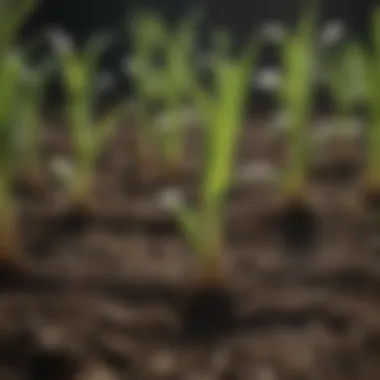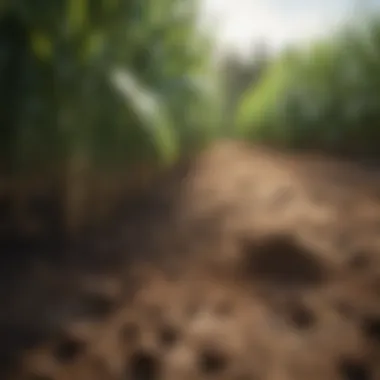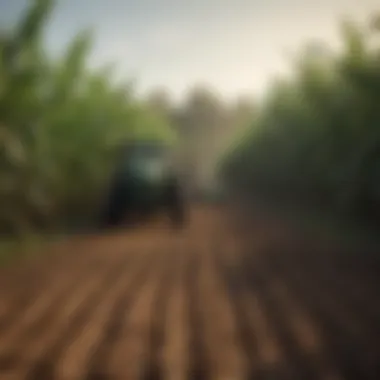When to Plant Corn in Florida: A Comprehensive Guide


Intro
Planting corn in Florida requires careful consideration of the state's unique climate and agricultural practices. This guide serves as a resource for both novice gardeners and experienced farmers. By understanding the optimal planting times, soil preparation techniques, and management strategies, you can significantly enhance your chances of a successful corn harvest.
Understanding Florida's Climate
Florida's climate is characterized by relatively mild winters and hot, humid summers. These conditions influence not only when to plant corn but also the types of corn varieties that thrive. Each region of Florida might experience slight variations in temperature and rainfall, which further impacts planting schedules.
"The right timing is crucial for maximizing yield and minimizing disease risk."
Thus, knowledge of local climate patterns is essential for effective planning.
Seasonal Planting Guides
For optimal corn production in Florida, adhere to the following seasonal guidelines:
- Spring Planting: The main growing season for corn. Begin planting from mid-March to early July. Hybrid varieties tend to perform well.
- Fall Planting: A secondary planting window occurs from late August to September for those interested in a fall crop.
Understanding frost dates is also important. Frost can damage young plants significantly, so be sure to plant after the last expected frost.
Soil Preparation and Management
Proper soil preparation is vital. Here are key steps:
- Soil Testing: Before planting, conduct a soil test to determine pH and nutrient levels. Ideal corn growth often occurs in slightly acidic to neutral soils (pH 6.0-7.0).
- Tillage: Prepare the soil through tillage to reduce weeds and improve aeration.
- Fertilization: Use fertilizers based on the soil test results. Nitrogen is particularly important for corn, as it promotes robust growth.
Maintenance includes regular irrigation, especially during dry spells, and monitoring for pests and diseases.
Maintenance and Care Tips
Once your corn is planted, ongoing care is important:
- Weed Control: Regularly manage weeds to prevent competition for nutrients.
- Pest Management: Monitor for common pests like the corn earworm and implement control measures.
- Harvesting: Corn is generally ready to harvest in 60 to 100 days, depending on the variety. Timing your harvest is critical for optimal taste and texture.
Finale
In summary, understanding when to plant corn in Florida requires careful attention to the state's climate conditions and agricultural practices. By adhering to seasonal guides and focusing on soil management, both beginner gardeners and seasoned farmers can achieve a successful crop. This knowledge empowers you to cultivate healthy corn effectively, ensuring a fruitful harvest. Remember to adapt practices to local conditions for the best results.
Understanding Florida's Climate
Understanding Florida's climate is essential for anyone looking to successfully plant corn. The state's weather conditions significantly impact planting decisions and crop yields. By grasping the nuances of Florida's climate, farmers and gardeners can make more informed choices about when to plant and how to manage their crops throughout the growing season.
Overview of Florida's Growing Seasons
Florida enjoys a subtropical climate, characterized by mild winters and hot, humid summers. This results in multiple growing seasons throughout the year. Generally, corn can be planted in spring and again in late summer for fall harvests.
- Spring Planting: The primary growing season typically starts in March and lasts until June. During this period, the weather begins to warm, providing optimal conditions for seed germination and early growth.
- Fall Planting: The secondary growing season starts in late July or early August, leading to harvests from September through November. This timing takes advantage of the remaining warm temperatures before winter.
By understanding these time frames, growers can plan their planting schedules effectively, leading to improved crop outcomes.
Impact of Humidity and Temperature
Humidity and temperature are crucial factors affecting corn growth in Florida. High humidity can influence pest activity and disease spread, while temperature fluctuations can affect seed survival and growth rates.
- Humidity: Florida's high humidity levels can create a favorable environment for fungal diseases. Growers must monitor moisture levels closely, ensuring proper spacing and air circulation between plants to reduce disease risk.
- Temperature: Corn thrives in temperatures ranging from 60°F to 95°F. However, extreme heat, especially during the pollination stage, can lead to kernel loss and reduced yields. It is important to monitor local forecasts and implement irrigation practices during heat spells to maintain optimal soil moisture.
Monitoring the climate variables plays a crucial role in ensuring successful corn cultivation in Florida. By keeping an eye on both humidity and temperature, farmers can adapt their strategies to mitigate environmental challenges.
Best Time to Plant Corn


Understanding the best time to plant corn is crucial for achieving optimal yields in Florida's distinctive climate. The timing affects the growth cycle, ensuring that the crop matures in alignment with favorable weather conditions. Planting at the right moment minimizes stress on the plants, enhances nutrient uptake, and ultimately leads to healthier harvest.
Several specific elements influence this timeline. Firstly, the local frost dates must be taken into account. Frost can devastate young corn plants, and knowing the last frost date helps in deciding the right time to plant. Additionally, soil temperature is significant; corn germinates best when soil temperatures reach around 60 degrees Fahrenheit.
In Florida, this awareness of seasonal change helps maximize growth periods. Corn can be successfully grown in both spring and fall, but understanding the local climate’s intricacies can result in vastly different outcomes. Below, we will explore the spring planting timeline and fall planting considerations to achieve the best results.
Spring Planting Timeline
Spring planting often starts around late March to early April in Florida. During this period, average temperatures are on the rise, and soil warms up sufficiently, providing an optimal environment for corn seeds to germinate. Specific local weather patterns can influence the exact timing, so it is important to monitor the conditions closely.
In a typical spring planting scenario:
- March: Begin preparations, including soil testing and amending as needed.
- April: Seed planting should commence as soil temperatures stabilize around 60°F.
- Mid-April to May: This is the peak germination time, with care needed to monitor moisture levels as rain can be frequent.
Monitoring the weather forecast is essential during this period, as unexpected late frosts or heavy rains could impact seed sowing negatively.
Fall Planting Considerations
Fall planting presents an alternative for corn cultivation. In Florida, this generally occurs from late July to early August. Experienced growers know that timing is especially critical in this season as the temperatures begin to decline.
Fall planting can offer benefits that spring planting cannot, such as reduced competition from other crops. However, the key factors to consider include:
- Temperature: Ensuring that soil temperatures are adequate for germination before cooler weather sets in.
- Day Length: Corn usually requires longer daylight hours for effective growth.
- Hurricane Season: Care must be taken to avoid potential storm damage late in the growing cycle.
Ultimately, while fall planting can yield good results, it necessitates close attention to local weather and the unique challenges that Florida’s fall season presents. Understanding these nuances will make a significant difference in ensuring crops thrive and deliver expected yields.
"Planting corn in Florida requires careful timing and an awareness of local climate patterns to ensure optimal yield and quality."
As farmers and gardeners consider when to plant corn in Florida, integrating these guidelines will help in making more informed decisions and improve overall success.
Preparation Before Planting
Preparing for planting corn is vital. This phase lays the groundwork for a successful harvest. Adequate preparation reduces risks and enhances crop growth. The right practices in this section set the foundation for what follows.
Soil Testing and Amendment
Testing soil is an essential step for any gardener. It provides crucial information about soil pH, nutrient levels, and overall health. Conducting a soil test lets you know what amendments are necessary. For example, corn thrives in well-drained, loamy soil. If the soil lacks nutrients or has an incorrect pH, adjustments must be made.
Common amendments include adding lime to raise pH or sulfur to lower it. Both help in creating a favorable environment for corn. Fertilizers can also be used to improve nutrient content. To execute this process effectively, follow these steps:
- Collect Soil Samples: Take samples from different areas of the planting site to ensure an accurate representation.
- Send for Testing: Use a reputable lab to analyze the soil properties.
- Interpret Results: Understand the recommendations provided by the lab.
- Apply Amendments: Based on the results, incorporate necessary adjustments into the soil.
Taking these steps will help achieve optimal conditions for corn growth.
Selecting the Right Corn Variety
Choosing the correct variety of corn is key to successful farming. Different varieties perform better under specific conditions. Factors like the environment, purpose of the crop, and desired traits should guide your selection.
When considering varieties, think about:
- Maturity Time: Select a variety that matures well within your growing season. Some varieties are early maturing, while others take longer.
- Disease Resistance: Some corn types are bred to resist common diseases. It is wise to choose those with good resistance to pests and diseases prevalent in Florida.
- End Use: Decide if the corn is for fresh eating, canning, or livestock feed. Each purpose may require a different type.
It's beneficial to consult local agricultural extensions or farmers in your area. They can provide insight into which varieties have performed well under regional conditions. This knowledge can save time and improve yield potential.
"Selecting the right corn variety can significantly boost yield and reduce input costs. Always consider local conditions and expert advice."
By focusing on these factors before planting, you pave the way for a productive corn crop.
Planting Techniques


Planting techniques are crucial for successful corn cultivation in Florida. Understanding the right methods not only enhances growth but also improves yield. The characteristics of Florida's climate demand specific planting strategies that cater to both environment and crop requirements. Beyond mere sowing, these techniques encompass various elements, each contributing to healthy growth and bountiful harvests.
Row Spacing and Planting Depth
Row spacing and planting depth are foundational aspects of planting corn. The spacing between rows influences airflow, light penetration, and nutrient access for each plant. In general, a row spacing of 30 to 36 inches is typical. However, in some areas, narrower spacing might be advantageous as it can lead to higher yields. The depth at which corn should be planted is also essential. Typically, planting should occur at a depth of 1.5 to 2.5 inches. This depth allows for optimal seed germination and root establishment. Planting too deep could inhibit emergence, while shallow planting can expose seeds to environmental stress.
Consideration of soil type is critical here. Sandy soils may dry out faster and require deeper planting, while clay soils retain moisture differently. Therefore, adjusting the row spacing and planting depth based on local conditions maximizes the growth potential.
Irrigation Practices Post-Planting
After planting, proper irrigation practices ensure that corn receives adequate moisture, especially in Florida's fluctuating weather patterns. Corn typically requires about 1 inch of water per week, with varying needs during different growth stages. Knowing when and how much to irrigate is essential for development.
Irrigation can be done using several methods, including drip irrigation and overhead systems. Drip irrigation delivers water directly to the root zone, minimizing wastage. In contrast, overhead systems provide water to the entire field but can lead to evaporation loss.
Timing of irrigation is just as important as the method. Early morning is the ideal time to water, as it allows plants to absorb moisture effectively before the heat of the day. Careful monitoring of soil moisture levels can guide adjustments in irrigation schedules. Overwatering should be avoided, as it can promote root disease and hinder growth.
Proper irrigation leads to healthier corn plants, which are more resilient to pests and diseases. Balanced moisture levels are key in achieving this goal.
In summary, implementing effective planting techniques is vital for growing corn successfully in Florida. Understanding row spacing, planting depth, and irrigation practices helps farmers achieve optimal growth, resulting in higher yields and healthier plants.
Managing Corn Growth
Managing corn growth is essential for achieving a successful yield in Florida's unique climate. In order to optimize your harvest, several key factors must be taken into account. Proper management throughout the growth stage ensures that plants receive the right nutrients, protection from pests, and appropriate care to flourish. Understanding how to manage growth can lead farmers to maximize both quantity and quality of corn.
Fertilization Strategies
Fertilization is a crucial element in managing corn growth. Corn requires plenty of nutrients, and its demand for nitrogen, phosphorus, and potassium is high. To create an effective fertilization strategy, consider the following:
- Soil Testing: Analyze the soil to determine nutrient levels. This helps in choosing the right fertilizers. Customizing your fertilizer plan can prevent deficiencies and excesses.
- Timing: Apply fertilizers during key growth stages. Early-season applications can support root development, while side-dressing during the growing season can enhance growth and yield.
- Types of Fertilizers: Opt for slow-release fertilizers to help ensure nutrients remain available over a longer period. Some farmers may use organic options, such as compost, which can additionally improve soil health.
"Properly managed fertilization can lead to stronger plants that produce greater yields."
- Application Method: Employ techniques like broadcasting or banding based on the field's needs. For example, banding near the crop row can increase nutrient absorption.
Pest and Disease Management
Monitoring and managing pests and diseases is vital to ensure healthy corn growth. Florida's climate can foster various challenges for crops. Therefore, proactive measures are necessary.
- Regular Monitoring: Regularly inspect plants for signs of pests, diseases, or nutrient deficiencies. Early detection can prevent a minor problem from escalating.
- Integrated Pest Management (IPM): Utilize IPM strategies that combine cultural, biological, and chemical practices. Encouraging beneficial insects can naturally control pest populations.
- Crop Rotation: Implement crop rotation to break pest cycles and improve soil health. This practice helps minimize the risk of soil-borne diseases.
- Disease-Resistant Varieties: Choose corn varieties that are resistant to common diseases in Florida, such as southern corn leaf blight. Knowledge of local issues is essential for making informed decisions.
Incorporating these strategies into your corn management practices will provide a strong foundation for plant health, ultimately leading to better crop performance and yield.
Harvesting Corn
Harvesting corn is a critical phase in the corn cultivation process. It marks the culmination of months of hard work, preparation, and care, translating the efforts of the grower into tangible results. Understanding when and how to harvest is essential for maximizing yield and ensuring the quality of the produce. The timing of the harvest greatly influences the corn's flavor, texture, and overall quality.
Identifying Ripeness
Knowing when the corn is ripe is vital. Corn should be harvested at the right time to achieve the best flavor and texture. Ripeness can be assessed by observing a few key indicators:
- Silk Condition: The silk on the corn ear should be brown and dry. When the silk is in this state, it indicates that the kernels are mature.
- Kernel Development: The kernels should be plump and firm. A simple test is to press a kernel with your fingernail; if a milky substance squirts out, the corn is ready to be harvested.
- Ear Tightly Filled: The ears should be well-filled out and should not have any gaps between the kernels.
It is important to monitor the corn closely as the time to harvest approaches. Ignoring these signs could result in harvested corn that is less than ideal for consumption or sale.
Tip: Harvest early in the morning or late in the evening when temperatures are cooler. This helps maintain the freshness of the corn post-harvest.
Methods of Harvesting
The method of harvesting corn is also significant to preserving its quality. There are several methods that can be used, depending on the scale of the operation:


- Hand Harvesting: This method is ideal for small gardens. It involves twisting the ear of corn off the plant, ensuring minimal damage to the plant and surrounding ears. It is important to wear gloves, as the corn silk can be irritating.
- Mechanical Harvesting: For larger operations, mechanical harvesting is efficient. Combines can be used for this purpose, efficiently collecting the corn and separating the kernels from the ears. This method requires knowledge of proper equipment handling and maintenance.
- Timing Considerations: Regardless of the method, timing remains crucial. Waiting too long can lead to an overripe product that is less palatable.
Post-Harvest Considerations
Post-harvest considerations are vital for ensuring the success of corn cultivation in Florida. This stage involves careful handling of the crop after it has been harvested. Proper post-harvest practices can significantly influence the quality, freshness, and longevity of your corn. They also assist in preparing for future planting seasons. Understanding these aspects can help farmers and gardeners maximize their yields while minimizing losses.
Storage Techniques for Optimal Freshness
Once the corn is harvested, how it is stored can impact its freshness and taste. There are several methods available for storing corn to maintain its quality:
- Cool and Dry Storage: Store corn at temperatures between 32°F and 40°F. This range helps to slow down the deterioration process. Ensure that the storage area is dry, as moisture can lead to mold.
- Refrigeration: If you plan to consume corn soon after harvesting, refrigeration can preserve its sweetness. Place the corn in a perforated plastic bag to allow airflow.
- Freezing: For long-term storage, blanch the corn for a few minutes and then freeze it. This process retains flavors and nutrients.
Planning for Next Year’s Crop
Planning for the next year’s crop begins right after the current season ends. Adopting a strategic approach can enhance future yields. Key elements to consider include:
- Soil Testing: After harvest, conduct soil tests to understand nutrient levels. This information guides amendments needed for the next planting.
- Crop Rotation: Implementing crop rotation helps maintain soil health. For instance, follow your corn crop with legumes to replenish nitrogen.
- Evaluate Pest Management: Assess the effectiveness of pest management strategies used in the current season. Learn from any issues faced to improve strategies.
In summary, effective post-harvest considerations can lead to improved storage techniques and better planning for subsequent plantings. This proactive approach is crucial for any successful corn cultivation operation.
Common Mistakes to Avoid
Understanding the common mistakes in corn planting is crucial for attaining successful yields. Florida's unique agricultural environment brings specific challenges and opportunities. Being aware of and avoiding these mistakes will not only save time and resources but also enhance the quality and quantity of your corn production. This section discusses two significant pitfalls: over or under planting and ignoring soil health.
Over or Under Planting
Over planting and under planting can lead to various issues. Over planting typically occurs when gardeners or farmers place too many seeds in a confined area. This results in excessive competition for resources such as nutrients, water, and sunlight. The plants may become stunted and grow poorly. Crowded plants are also more prone to diseases, which can further reduce yield.
On the other hand, under planting can lead to sparse crops. Insufficient planting can result from poor planning or a lack of knowledge about suitable planting densities. A low seed count per acre might allow weeds to thrive, taking away essential nutrients from the soil.
To achieve an optimal corn yield, it is fundamental to determine the appropriate planting density. This density typically varies by corn variety and the environmental conditions of the field. Gardeners should consult local agricultural extension services to find suitable recommendations for the area.
Ignoring Soil Health
Soil health is vital for corn production and should never be overlooked. Ignoring soil health can lead to reduced yields and poor crop quality. Healthy soil provides essential nutrients and supports plant growth by enhancing root development. Without paying attention to the condition of the soil, corn plants may struggle to thrive.
Key components of soil health include:
- Nutrient balance: Ensuring the soil contains adequate levels of nitrogen, phosphorus, and potassium.
- Soil structure: Maintaining good aeration and water retention to encourage root growth.
- Microbial activity: A healthy population of microbes helps to decompose organic matter and enhance nutrient availability.
To maintain soil health, periodic soil testing is recommended. This testing detects any deficiencies or imbalances in the soil that require amendments. Adding organic matter, such as compost, can also improve soil structure and fertility, providing a better environment for corn growth.
By focusing on these specific elements, gardeners and farmers can avoid common mistakes and significantly improve their corn planting success in Florida.
Resources for Further Learning
Understanding the intricacies of corn cultivation in Florida can significantly enhance yield and productivity. Knowledge is crucial for success in gardening or farming. This section aims to provide resources that can further enlighten readers about best practices and methodologies. Accessing the right information can help gardeners make well-informed decisions, address issues as they arise, and adapt strategies effectively to local conditions.
When it comes to cultivating corn, a comprehensive understanding of the climate, soil, and crop management is vital. Resources serve as tools to equip homeowners and gardening enthusiasts with skills and insights necessary for successful corn farming in Florida.
Extension Services in Florida
Extension services are vital in the support of agricultural education. Florida has a network of county extension offices that provide localized information and expertise. These offices offer workshops, classes, and one-on-one consultations for corn growers of all experience levels. Topics can include soil management, pest control, and crop rotation strategies.
Some benefits of utilizing extension services are:
- Personalized Support: Access to expert advice tailored to individual needs and local conditions.
- Current Research: Information based on the latest agricultural research helps ensure the best practices.
- Community Engagement: Extension offices often host events and workshops that foster community involvement and learning.
Readers can find more information on local extension offices by visiting the University of Florida Institute of Food and Agricultural Sciences website at IFAS Extension.
Books and Online Guides
In addition to extension services, a plethora of books and online guides exist to bolster knowledge on corn cultivation. These resources cover various topics, from basic gardening techniques to advanced agricultural practices. They are specifically valuable for those who prefer self-paced learning. Here are some noteworthy mentions:
- “Florida's Best Fruiting Plants” by Tom MacCubbin: This book provides insights into growing fruits and vegetables in Florida's diverse climates, including corn.
- “The Vegetable Gardener's Bible” by Edward C. Smith: While broader in scope, this classic resource includes useful information on corn planting and care.
- Gardening Websites: Online platforms like Rodale's Organic Life and Gardener's Supply Company offer numerous articles and blogs dedicated to gardening techniques, including corn cultivation.
Accessing these resources enables growers to deepen their understanding and implement more effective planting, management, and harvesting techniques. By continuously learning, both novice and experienced gardeners can refine their practices and ultimately achieve better outcomes.



